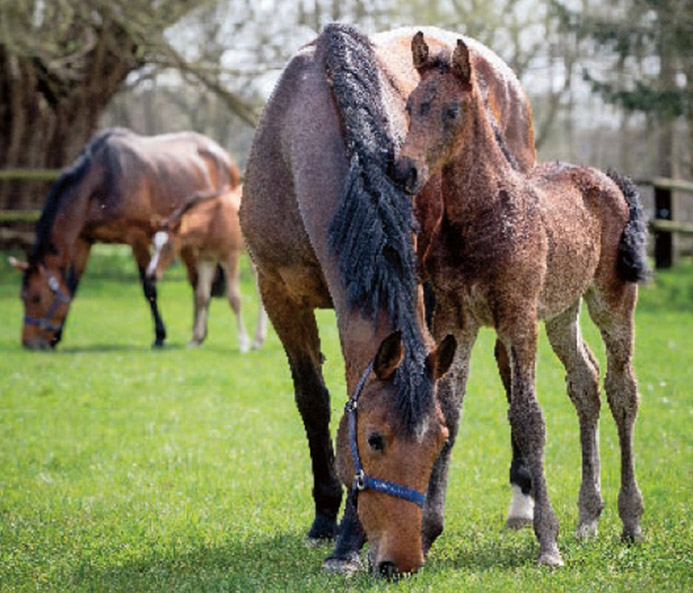Photo by Hippo Foto/Dirk Caremans
Breeding – the cycle of life
Publication date: 25th September
As I write this in late Spring sunshine looking out at the paddocks with the mares and foals, it’s easy to remember their time in competition and the journeys we have been on together. Each mare has a book of success and failings, the victories, the rolled poles or injuries at a crucial time, but most of all the happiness when they have succeeded or gone clear and of course the foals they have bred come to mind. There is a very comforting familiarity in the ‘cycle of life’, breeding horses that go on to compete themselves and then return to produce future generations.
A journey
When selecting a mare, particularly when hoping to breed from her people generally look for good conformation, temperament and breeding soundness. Owning a mare is a journey of different phases, and the successful ones frequently become friends as well as broodstock. With Artificial Insemination and embryo transfer becoming commonplace breeding soundness is important because often mares are in competition as well as producing foals via surrogate dams at stud. A horse with good reproductive conformation will be easier and take less time to conceive.
Similarly, when selecting a recipient mare it’s wise to take time and lease a mare from an expert rather than take a horse from a friend because it’s cheap and easily available.
Insuring broodmares is easy and inexpensive. Mortality coverage is relatively cheap and I would recommend also buying Life Saving Surgery vet fees which will does what it says on the box and will pay, amongst other things, for colic surgery or a C-Section delivery if there is a problem whilst foaling. An owner with more than 10 mares should consider buying cover on a “First Loss” or “deductible” basis where there is a degree of self- insurance, rather than insuring each mare individually. This will reduce premiums and a well managed broodmare band is unlikely to suffer multiple losses in a year. When using a recipient mare following embryo transfer don’t forget the owner may require her to be insured for the period of the pregnancy and foaling.
Peace of mind.
I often have requests from clients to insure mares whilst they have leased them for breeding. In that case it is wise to remember the risk may also need to include some form of loss of use cover if it is a young mare and the owner envisages a future competition career. Alternatively, clients buy mortality and loss of breeding ability Insurance when they have leased a mare for competition and the owner wants it returned for a breeding career later in life. Owners with homebred mares insure against them suffering an injury that will prevent them successfully breeding, the cost of this is relatively low and the policy provides financial compensation and peace of mind.
The costs
Standard veterinary fee insurance is of course easily available for a broodmare, but I always remind clients that a complicated Colic surgery or dystocia problem can cost in excess of €7-8,000. I believe it is a false economy to buy a vet fee policy with a limit of €5,000 unless the insured accepts they will be co-insuring the cost in the event of a serious problem. Whilst talking about Vet fee insurance on a broodmare always make sure foaling problems are not excluded
Prospective Foal coverage insures the embryo against death or failing to become a healthy viable foal and can be purchased for pregnancies either via the natural mother or a surrogate dam.
While discussing surrogate mares, advances in Embryo Transfer techniques mean mares can be kept in training whilst also producing foals. This is an exciting option for mare owners offering both multiple foals and a longer breeding career. However, without wishing to be negative about what is an exciting concept, it is worth remembering that at the best facilities with fertile stallions our figures suggest that if a stallion’s fertility rate over 3 covers is 80% (the best stallions), the chances of a successful embryo transfer into an recipient mare is 80% (at the best facilities) and the chance of the surrogate mare delivering a live foal is 80% (a good quality mare), the actual chance of a live foal resulting is around 50%. Less experienced facilities will fall short of this success rate and the best may well exceed it. If the stallion is less fertile, the transfer clinic not experienced or the recipient mare not in prime condition, the figures may change dramatically. I mention these figures as an explanation of the cost and speciality involved insuring foetuses.
In summary there are risks involved breeding mares that can be covered by insurance, but the joy of doing it successfully and seeing the foals go on to be winners is immense. Insurance on a broodmare is easy to arrange and as well as providing peace of mind does give financial benefit if something goes wrong.
If you have any questions and/or comments regarding insurance matters, please contact us on telephone: +44 203 968 8600 or email: [email protected].



